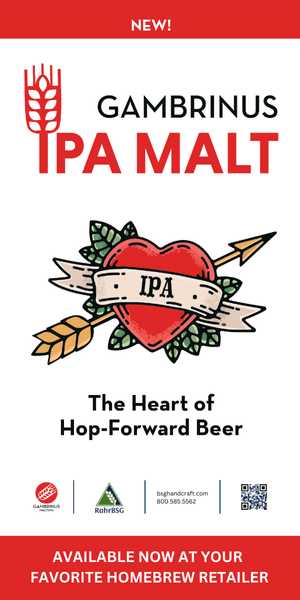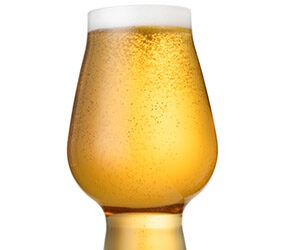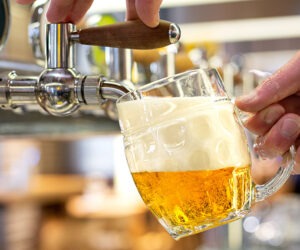Vienna Lager: Tips from the Pros
Vienna lager’s origins come from its namesake city in Austria, and some of the most popular commercial examples are brewed in Mexico. But you don’t need a passport to find some great Viennas. We found three US brewers who understand what it takes to brew a good Vienna lager.
Brewer: James Moriarty, Pennichuck Brewing Company in Milford, NH
Our Vienna lager recipe comes down from the original head brewer and it’s since taken on its own character and become lighter in color than what it may typically be style-wise. Ours is more of a pale gold to a light copper color. We are planning on releasing it either this year or next year as Ladder 1 Lager, though it was originally on the market as 2-6-0 Mogul. I think people were kind of uncomfortable with the original name — for example, we attended a festival and it just wasn’t pouring so we swapped out the tap handle for a Ladder 1 Lager and we couldn’t stop pouring it.
We use three types of malts to brew our Vienna: standard two-row pale, Vienna and Caramunich 40 °L. We also use a single bag of wheat malt in 30 barrels to help with head retention and give a little bit of mouthfeel. For hops we use Nugget as the bittering hop, Czech Saaz and Hallertau as the aroma and flavor hops. I think it comes out to about 19 or 20 IBUs.
We do a single infusion mash where we mash in at 152 °F (67 °C), give it a 40 minute rest then sparge at 165 °F (74 °C). We have a 15-barrel brewhouse and when we do a 30-barrel batch we split the mash temps between the two days — 149 °F (65 °C) on the first day and get a lot of the fermentables. On the second day we’ll do 151 to 152 °F (66 to 67 °C) to get more of the body.
We use Wyeast German Lager for yeast, although we are a little tough on our yeast so we kind of beat the esters out of it. To cut down on the lag time we like to pitch at 65 °F (18 °C), then over the course of two days we bring it down to the fermentation temperature — around 50 °F (10 °C). If I was a homebrewer I would forgo the airlock during primary and setup a blowoff tube to let the sulfur escape.
We don’t use any finings, but you’re going to want to get the beer as clear as possible, especially if it is on the lighter side. When you’re ready to bottle you can use something like isinglass.
Brewer: David Berg, August Schell Brewing Co. in New Ulm, MN
The philosophy behind Firebrick was to create a malt-forward amber lager with enough bitterness to prevent the beer from becoming cloying. The sweet malt character needed to come from high-temperature kilned malts rather than crystal malts.
Firebrick is an all-malt lager. The grain bill consists of Rahr 2-Row, Munich malt, medium crystal and black malt. The Munich malt provides the toasty, breadlike character while the small amount of black malt provides a nice red color.
Vienna lagers should exhibit a very clean bitterness. Good hop choices include German Noble varieties (Hallertau, Tettnang) or their American counterparts (Liberty, Mt Hood). Firebrick uses all Liberty hops, with additions at first wort and the start of boil yielding a low, but present, amount of hop flavor. The bitterness is 22 IBUs.
We ferment Firebrick with one of our house lager yeast strains, which is a descendent of the Christian Schmidt strain. It’s a workhorse yeast that likes higher temperatures, so we ferment at 57 °F (14 °C). Fermentation completes in seven days and is followed by a 21-day lagering period.
At home, build your grain bill around the concept of creating a beer with a nice toasty malt character. Vienna and Munich malts will give you what you’re looking for. Some Caravienne would also go a long way towards achieving your goal. A small amount of Black malt (0.5%) will give you a nice red color without affecting the flavor. Shoot for an original gravity somewhere between 12 and 14 °Plato, and use enough hops to balance the malt sweetness without becoming overbearing.
Homebrewers should be able to brew world-class Viennas (or any lagers for that matter) as long as they remember to pitch enough yeast and control your temperature. The amount of yeast you pitch for a lager should be 1.5 to 2 times the amount you use in an ale. Yeast companies list the temperature range for their yeasts. Follow their advice.
Brewer: Jamie Fulton, The Covey Restaurant and Brewery in Fort Worth, TX
The Vienna lager served at The Covey is brilliantly clear, light copper in color with a thick, off-white head. The aroma is clean, with sweet malt dominating and faint noble hop aroma in the background. When I formulated my original recipe, I wanted to highlight the subtleties of the lightly toasted malts, predominantly Munich malt. Fairly low hopping rates allow the malt to shine through, but there is just enough bitterness to keep it very drinkable.
Munich malt and Pilsner malt, in equal amounts, account for three/fourths of the grist. For specialty malts, I use two different light crystal malts and a portion of Vienna malt. Using dark crystal malts will add a harshly toasty/caramel flavor that I think detracts from the drinkability and balance that is so important to this beer’s character. The Munich malt adds the hallmark bready and lightly toasted flavors. The addition of the light crystal malts, in small amounts, adds to the overall complexity of the beer, making it rounder and more balanced.
I use noble, low alpha acid hops for the bittering and flavor additions. I would not recommend using high-alpha varieties for a beer this mild. I aim for around 20 IBUs for the finished beer, with 20% coming from the flavor addition.
I use a Bavarian lager yeast for the ferment. I like the small amount of sulfur these yeasts produce. The strain that I use from White Labs leaves the beer malty with very slight sulfur. Our fermentation regime is to pitch at around 47.5 °F (8.6 °C) with moderate O2 levels.
Some tips for homebrewers: acidify sparge water with lactic acid to just below pH 7 and do not sparge at a temperature higher than 170 °F (77 °C). Use fresh, liquid yeast, preferably do a starter and pitch one to two pints of slurry per 10 gallons (38 L). Oxygenation of the cooled wort is critical: use a sterile in-line filter and a carbonation stone to infuse the cooled wort with O2, but do not do this so vigorously as to create lots of foam. Use your best, low-alpha hops for bittering and preferably noble hops for flavor. Controlling the temperature is one of the most difficult aspects of homebrewing, but is crucial to crisp Vienna lager. Do not ferment over 55 °F (13 °C) maximum. Rack from secondary five to seven days after lowering the temp to around 40 °F (4 °C).



